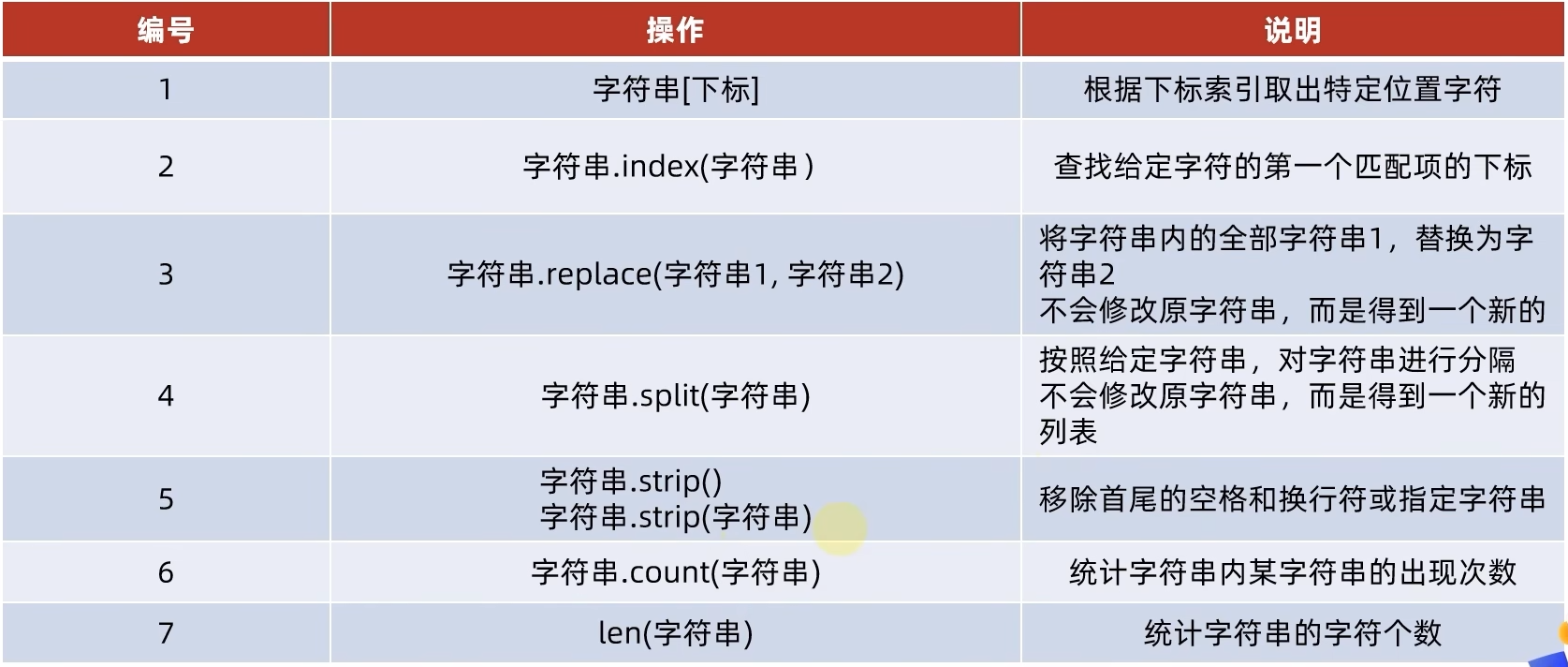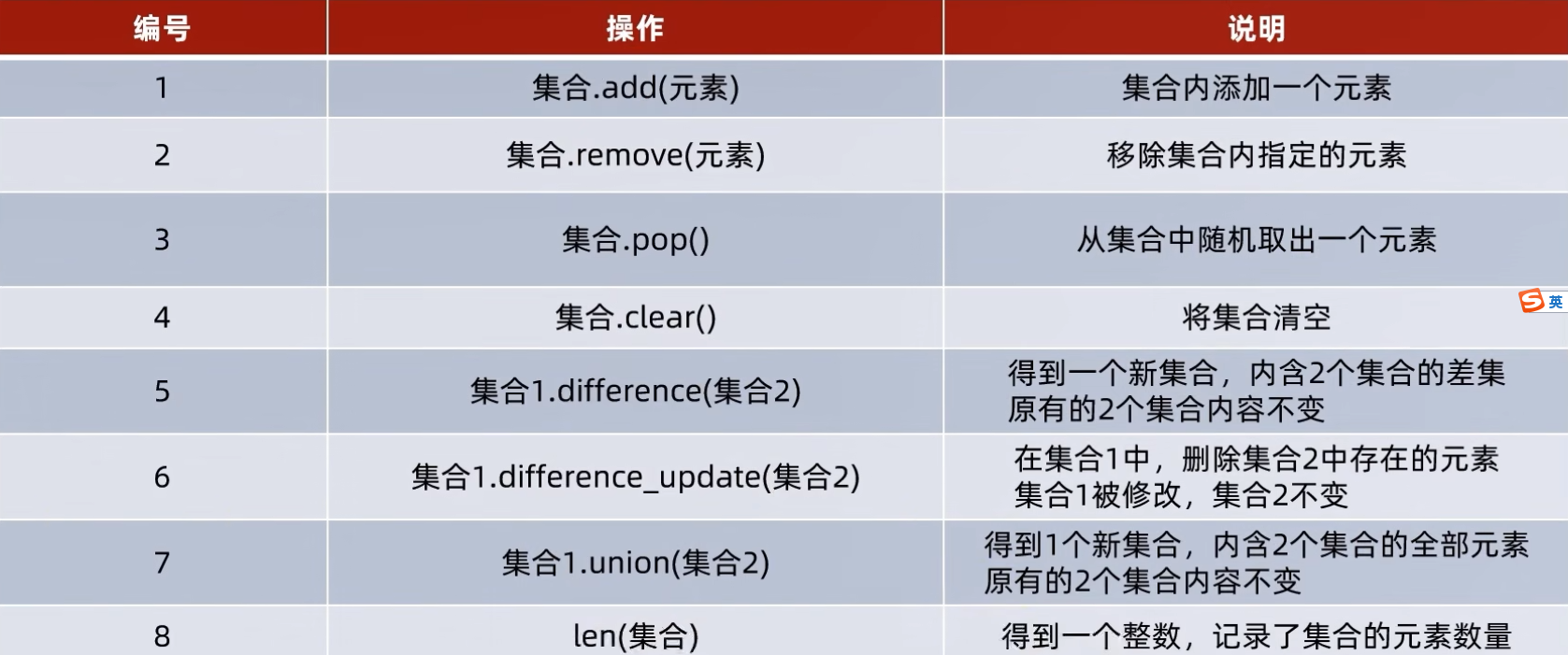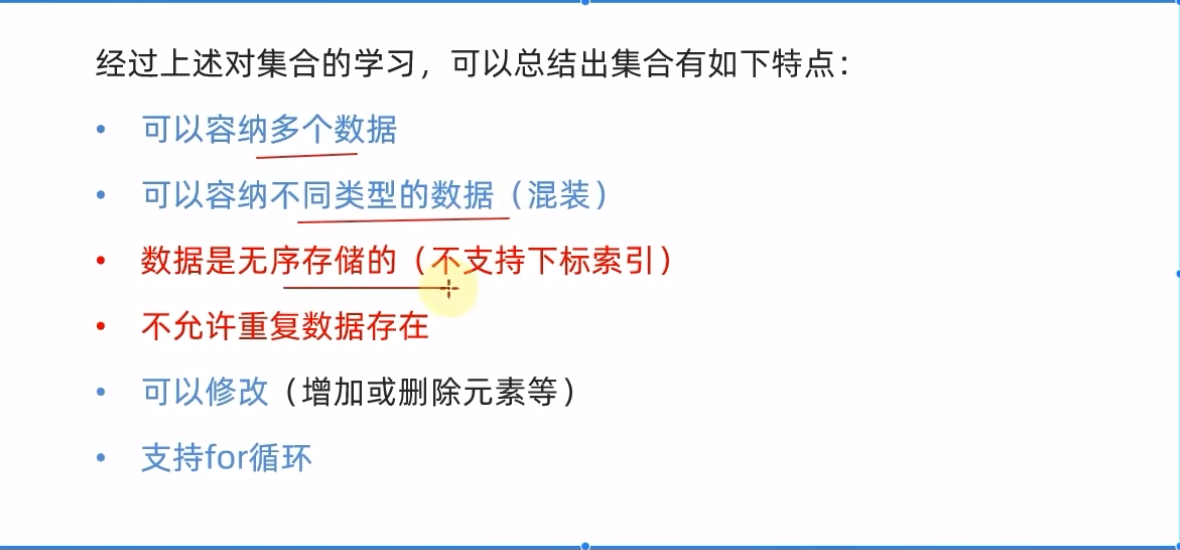
"""
演示以数据容器的角色,学习字符串的相关操作
"""
my_str = "itheima and itcast"
# 通过下标索引取值
value = my_str[2]
value2 = my_str[-16]
print(f"从字符串{my_str}取下标为2的元素,。值是:{value},取下标为-16的元素。值是:{value2}")
# my_str[2] = "H"
# index方法
value = my_str.index("and")
print(f"在字符串{my_str}中查找and,其起始下标是:{value}")
# replace方法
new_my_str = my_str.replace("it", "程序")
print(f"将字符串{my_str},进行替换后得到:{new_my_str}")
# split方法
my_str = "hello python itheima itcast"
my_str_list = my_str.split(" ")
print(f"将字符串{my_str}进行split切分后得到:{my_str_list}, 类型是:{type(my_str_list)}")
# strip方法
my_str = " itheima and itcast "
new_my_str = my_str.strip() # 不传入参数,去除首尾空格
print(f"字符串{my_str}被strip后,结果:{new_my_str}")
my_str = "12itheima and itcast21"
new_my_str = my_str.strip("12")
print(f"字符串{my_str}被strip('12')后,结果:{new_my_str}")
# 统计字符串中某字符串的出现次数, count
my_str = "itheima and itcast"
count = my_str.count("it")
print(f"字符串{my_str}中it出现的次数是:{count}")
# 统计字符串的长度, len()
num = len(my_str)
print(f"字符串{my_str}的长度是:{num}")
集合


"""
演示数据容器集合的使用
"""
# 定义集合
my_set = {"传智教育", "黑马程序员", "itheima", "传智教育", "黑马程序员", "itheima", "传智教育", "黑马程序员", "itheima"}
my_set_empty = set() # 定义空集合
print(f"my_set的内容是:{my_set}, 类型是:{type(my_set)}")
print(f"my_set_empty的内容是:{my_set_empty}, 类型是:{type(my_set_empty)}")
# 添加新元素
my_set.add("Python")
my_set.add("传智教育") #
print(f"my_set添加元素后结果是:{my_set}")
# 移除元素
my_set.remove("黑马程序员")
print(f"my_set移除黑马程序员后,结果是:{my_set}")
# 随机取出一个元素
my_set = {"传智教育", "黑马程序员", "itheima"}
element = my_set.pop()
print(f"集合被取出元素是:{element}, 取出元素后:{my_set}")
# 清空集合, clear
my_set.clear()
print(f"集合被清空啦,结果是:{my_set}")
# 取2个集合的差集
set1 = {1, 2, 3}
set2 = {1, 5, 6}
set3 = set1.difference(set2)
print(f"取出差集后的结果是:{set3}")
print(f"取差集后,原有set1的内容:{set1}")
print(f"取差集后,原有set2的内容:{set2}")
# 消除2个集合的差集
set1 = {1, 2, 3}
set2 = {1, 5, 6}
set1.difference_update(set2)
print(f"消除差集后,集合1结果:{set1}")
print(f"消除差集后,集合2结果:{set2}")
# 2个集合合并为1个
set1 = {1, 2, 3}
set2 = {1, 5, 6}
set3 = set1.union(set2)
print(f"2集合合并结果:{set3}")
print(f"合并后集合1:{set1}")
print(f"合并后集合2:{set2}")
# 统计集合元素数量len()
set1 = {1, 2, 3, 4, 5, 1, 2, 3, 4, 5}
num = len(set1)
print(f"集合内的元素数量有:{num}个")
# 集合的遍历
# 集合不支持下标索引,不能用while循环
# 可以用for循环
set1 = {1, 2, 3, 4, 5}
for element in set1:
print(f"集合的元素有:{element}")

